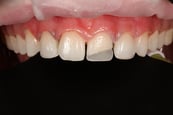Written By: Michelle Chan, Abir Bou Khouzam, and Lisa Jeong
An Economic Way to Complete Costly Orthodontic Treatments with Composite Veneers
In today’s world, societal pressures and expectations have compelled an increasing amount of people to become more conscious about their dental hygiene and the look of their smile. Having a beautiful smile has continuously increased in popularity and is believed to boost self-esteem and confidence.
According to the Dental Industry Association of Canada (DIAC)’s Twelfth Annual Future of Dentistry Survey in 2020, 26% of dentists surveyed said they will be completing more veneer cases in the next two years while 47% expected their volume will remain the same. Veneers are becoming a more common way to improving one’s appearance. Many patients consider them a long-term investment; yet striking a balance between affordability and quality remains a challenge for many.
Providing cost-effective solutions for patients is at the forefront of every dental practice. Direct composite veneers are a proven way to address both the need for cost savings and highly esthetic, durable results.
Patients want to be “wowed” by the results, especially in cosmetic treatments, but also expect functional, enduring restorations. There is little margin for error with veneers, so it is essential to get them right the first time. By using OMNICHROMA and OMNICHROMA BLOCKER, dentists can achieve results that are both beautiful and reliable while keeping costs low, and procedures speedy and minimally invasive.
OMNICHROMA uses its innovative Smart Chromatic Technology to replicate naturally occurring structural color. OMNICHROMA’s supra-nano spherical fillers diffuse the red-yellow-colored wavelengths of light that human teeth fall under. It has the strength and durability needed for posterior restorations as well as the polishability and esthetics desired for anterior restorations. OMNICHROMA’s ability to shade match any tooth shade from A1 to D4, excellent esthetics, high strength, and minimal wear makes it the material of choice for many clinicians.
The below cases present excellent examples of an economical way to complete costly orthodontic treatments with composite veneers.
Read below for the techniques Dr. Kevin Brown of Bellevue, WA, and Dr. Ross Nash of Huntersville, NC use in their practices to create direct composite veneers that will indeed ‘wow’ their patients for years to come.
Case #1: Dr. Kevin Brown
Noah is a 15-year-old with a fractured tooth #9 that was repaired with a universal composite in his youth. As he neared the end of his orthodontic treatment, he was advised by the orthodontist to replace the older composite and reduce the spacing in the maxillary anterior. Due to his age, porcelain was not an option due to the necessity of heavy tooth preparation, so direct composite veneers were the treatment of choice. Noah voiced his concern over the new composite looking fake like the previous composite.
In cases like this, dentists often use polychromatic layering techniques to achieve the ultimate esthetics. Dr. Brown opted to use OMNICHROMA for its ease of use and incredible color matching results. A frontal view shows the previous repair on tooth #9 and post-orthodontic residual spacing. A minimally invasive preparation of tooth #9 was done after removing the older composite and a conservative long bevel along the facial surface was created to allow for better bonding strength and smoother color blending. A lingual shelf was established on teeth #7, 9, & 10 using OMNICHROMA and a silicone putty index. Because this patient has some mild incisal edge translucency, it was decided to use OMNICHROMA as a lingual shelf and the dentin layer was recreated using OMNICHROMA Blocker.
 |
 |
 |
 |
|
1. Pre-operative full smile
|
2. Minimally invasive preparation to tooth #9. After removing the old composite a conservative long bevel along the facial surface was created to allow for better bonding strength and also for better color blending. The other teeth were prepared with air abrasion only.
|
3. Lingual shelf established with OMNICHROMA and silicon putty
|
4. Dentin layer created with Blocker. Care was taken to only use enough to block out the hard incisal edge fracture line on the natural tooth. This layer was feathered onto the long facial bevel by a few millimeters and a natural dentin morphology was created on the incisal portion.
|
|
|
|
|
|
|
5. Lateral view of Blocker layer to show how it feathers onto the facial bevel and is not overly thick
|
6. Final layer of OMNICHROMA layered to full contour |
7. Final result: retracted view |
8. Final result: full smile |
Case #2: Dr. Ross Nash
Ali is a 16-year-old who has just finished orthodontic treatment. His maxillary anterior teeth were unusually narrow, so spaces between his teeth still existed post-orthodontic treatment. The natural teeth were approximately A1, however, with a single shade composite like OMNICHROMA, no shade taking was necessary. OMNICHROMA Blocker was applied in the interproximal areas and OMNICHROMA for the facial on the six direct composite veneers for teeth numbers 6-11.
|
 |
 |
| 1. Pre-operative: full smile | 2. Post-operative: full smile |
 |
 |
| 3. Pre-operative: upper occlusal view | 4. Post-operative: upper occlusal view |
For more info on how to use Blocker, watch Dr. Brown’s
"When & How to use Blocker"
Innovated to match VITA shades from A1 to D4 with only one shade, OMNICHROMA is the answer to your needs: with its versatility of use, high strength, minimal wear and excellent esthetic.
OMNICHROMA and OMNICHROMA Blocker are the products to rely on, worry-free, for any class of restoration, direct anterior & posterior restorations, diastema closures, veneers and porcelain repairs.




